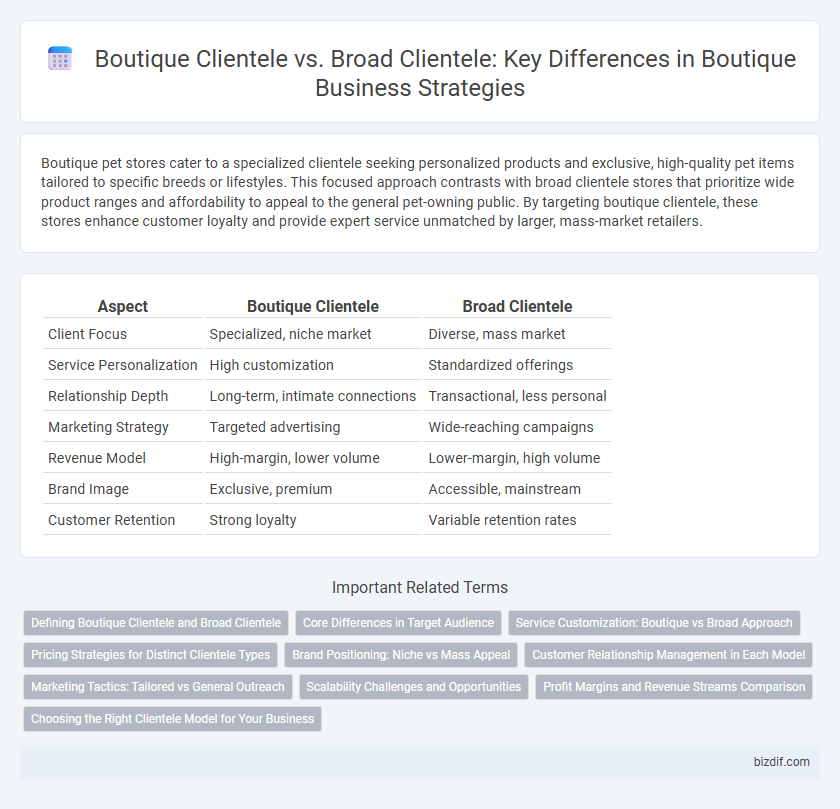Boutique pet stores cater to a specialized clientele seeking personalized products and exclusive, high-quality pet items tailored to specific breeds or lifestyles. This focused approach contrasts with broad clientele stores that prioritize wide product ranges and affordability to appeal to the general pet-owning public. By targeting boutique clientele, these stores enhance customer loyalty and provide expert service unmatched by larger, mass-market retailers.
Table of Comparison
| Aspect | Boutique Clientele | Broad Clientele |
|---|---|---|
| Client Focus | Specialized, niche market | Diverse, mass market |
| Service Personalization | High customization | Standardized offerings |
| Relationship Depth | Long-term, intimate connections | Transactional, less personal |
| Marketing Strategy | Targeted advertising | Wide-reaching campaigns |
| Revenue Model | High-margin, lower volume | Lower-margin, high volume |
| Brand Image | Exclusive, premium | Accessible, mainstream |
| Customer Retention | Strong loyalty | Variable retention rates |
Defining Boutique Clientele and Broad Clientele
Boutique clientele consists of a specialized, niche group of customers seeking personalized services and unique products tailored to their specific preferences. Broad clientele encompasses a wide, diverse audience with varying needs, requiring scalable and adaptable offerings to appeal to mass markets. Defining boutique clientele involves emphasizing exclusivity and customization, while broad clientele prioritizes reach and volume.
Core Differences in Target Audience
Boutique clientele typically consists of niche, high-value customers seeking personalized, exclusive products or services tailored to specific tastes and preferences. Broad clientele targets a diverse, larger market segment with more generalized offerings designed to appeal to a wide range of demographics and needs. Core differences in target audience lie in the level of customization, purchasing power, and engagement, with boutique clients valuing exclusivity and bespoke experiences, while broad clientele prioritizes accessibility and variety.
Service Customization: Boutique vs Broad Approach
Boutique clientele benefit from highly personalized service customization tailored to individual preferences, resulting in unique and exclusive experiences that drive client loyalty. In contrast, broad clientele services rely on standardized offerings designed to appeal to a wide audience, emphasizing efficiency and scalability over personalization. This strategic difference allows boutique businesses to excel in niche markets while broad clientele models focus on volume and accessibility.
Pricing Strategies for Distinct Clientele Types
Boutiques catering to a niche clientele often implement premium pricing strategies to reflect exclusivity and personalized service, leveraging high perceived value to maximize profit margins. In contrast, boutiques targeting a broad clientele adopt competitive pricing models, focusing on affordability and volume sales to attract a wider customer base. Tailoring pricing strategies to the distinct expectations and purchasing behaviors of boutique versus broad clientele enhances profitability and brand positioning.
Brand Positioning: Niche vs Mass Appeal
Boutique brands target a niche clientele seeking exclusive, personalized experiences that emphasize quality and uniqueness, enhancing brand positioning through tailored offerings and premium perception. Broad clientele brands focus on mass appeal, leveraging wide accessibility and competitive pricing to maximize market reach and brand visibility. This strategic divergence shapes marketing tactics, product development, and customer engagement, defining each brand's identity and market influence.
Customer Relationship Management in Each Model
Boutique clientele models prioritize personalized Customer Relationship Management, fostering deep connections through tailored services and exclusive experiences that drive customer loyalty and satisfaction. Broad clientele approaches utilize scalable CRM technologies and data analytics to manage large customer bases efficiently, focusing on segmentation and automated communication to optimize engagement. Each model demands distinct CRM strategies: boutique emphasizes customization and high-touch interactions, while broad relies on systematic processes to handle volume and diverse customer needs.
Marketing Tactics: Tailored vs General Outreach
Boutique clientele demands marketing tactics that emphasize personalized engagement, leveraging data-driven insights to craft tailored messages that resonate with niche segments. In contrast, broad clientele strategies rely on general outreach campaigns, utilizing mass media and wide-reaching platforms to capture diverse audience interests. Effective boutique marketing integrates targeted social media ads, exclusive events, and customized content to build strong loyalty and brand affinity.
Scalability Challenges and Opportunities
Boutique businesses targeting a specialized clientele benefit from deep customer relationships and tailored services, but face scalability challenges due to limited market size and resource constraints. Broad clientele models enable expansion and higher revenue potential through mass appeal, yet risk diluting brand identity and increasing operational complexity. Strategic use of technology and data analytics can help boutiques overcome scalability barriers while maintaining personalized experiences.
Profit Margins and Revenue Streams Comparison
Boutiques targeting a niche clientele typically achieve higher profit margins due to personalized services and exclusive product offerings that command premium prices. Broad clientele businesses benefit from diversified revenue streams and larger sales volumes but often experience thinner profit margins because of discounting and higher operational costs. Focusing on specialized customer segments allows boutiques to maximize revenue per client while minimizing competition-driven price wars common in broad markets.
Choosing the Right Clientele Model for Your Business
Choosing the right clientele model significantly impacts a boutique's brand identity and customer experience, with boutique clientele emphasizing personalized service, exclusivity, and tailored offerings to a niche market. Broad clientele models focus on mass appeal and higher volume sales, which may sacrifice customization but increase reach and market share. Evaluating factors such as business goals, product uniqueness, and desired customer engagement helps determine whether a boutique or broad clientele strategy aligns best with long-term success.
Boutique Clientele vs Broad Clientele Infographic

 bizdif.com
bizdif.com